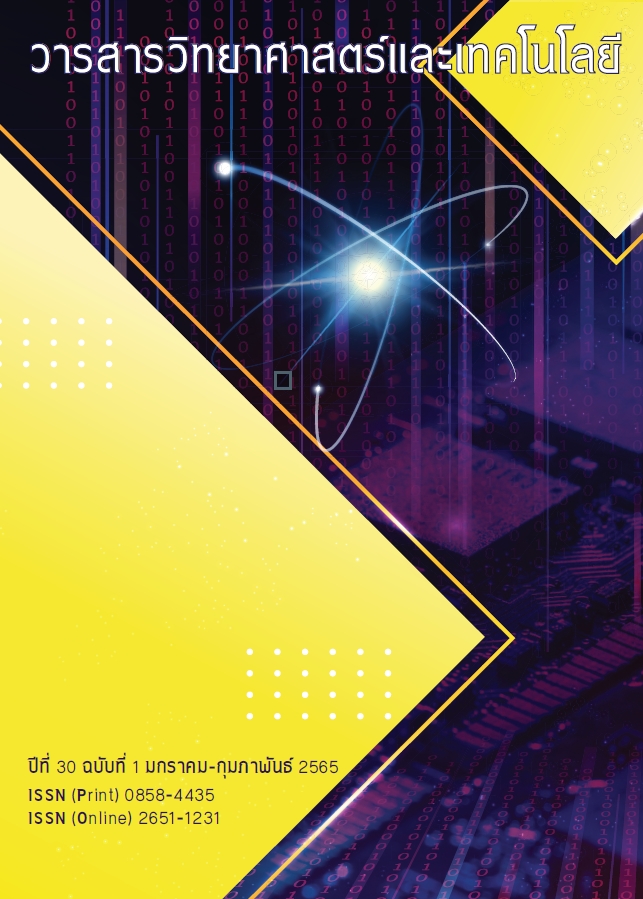Nutritional Value and Ruminal Digestibility of Mahasarakham Dwarf Elephant Grass (Pennisetum purpureum cv. Mahasarakham) Silage Supplemented with Soymilk
Main Article Content
Abstract
Dwarf elephant grass cv. Mahasarakham (Pennisetum purpureum cv. Mahasarakham) is a popular forage in the northeastern region of Thailand, which is abundant grazing rainy season. Conserving this forage as silage would provide an adequate roughage feed supply for ruminants during the dry season. This experiment was conducted to investigate the nutritional value and ruminal digestibility of dwarf elephant grass cv. Mahasarakham (Pennisetum purpureum cv. Mahasarakham) silage supplemented with soymilk residue at 0 %์ (the control), 10 %์, and 15 %์. The obtained results showed that dry matter, organic matter, gross energy, and crude protein of dwarf elephant grass cv. Mahasarakham silage supplemented with soymilk residue were increased when compared to the control (P<0.01). Dwarf elephant grass cv. Mahasarakham silage supplemented with soymilk residue at 15 %์ had the highest dry matter, organic matter, and crude protein (24.24, 89.70, and 17.92 %์, respectively) and contained gross energy up to 4,141.67 cal/g. NDF and ADF were found lowest, and dry matter digestibility was increased from 37.55 (the control) to 53.17 %์ (P<0.05) when the silage was supplemented with 15 %์ soymilk residue.
Article Details
References
Srichana, D., 2002, Dairy Farm Management, Department of Agricultural Technology, Faculty of Science and Technology, Thammasat University, Rangsit Campus, Pathum Thani, 180 p. (in Thai)
Wilkinson, J. M., Wadephul, F. and Hill, J., 1996, Silage in Europe, a survey of 33 countries, Chalcombe Publications, Welton, UK.
Khejornsart, P. and Juntanam, T., 2016, Effects of forage sorghum silage and Napier silage on production performance in meat goat, KHON KAEN AGR. J, 44(1):517-522. (in Thai)
Animal Feed and Veteinary Product Control., 2004, Standard of Silage, Department of Livestock Development, Ministry of Agriculture and Cooperatives, Bangkok, 28. p (in Thai)
Mapato, C. and Wanapat, M., 2017, Sweet grass (Pennisetumpurpureumcv. Mahasarakham), a new alternative grass for ruminant, Dairy Journal, 34(2): 57-63.(in Thai)
Chaikong, C., Chantiratikul, A., Sringam,K., Himlee, P., Kumchim, S., Boontod, A. and Arunronwanit, M., 2018, Cutting intervals on growth characteristics, yields and nutritive values of Pennisetum purpureum cv. Mahasarakham grass under irrigation system during cold season,Khon Kaen Agr. J., 46(1): 158-164. (in Thai)
AOAC., 1995, Official Method of Analysis,15th ed, Association of Official AnalyticalChemists, Arlington, V.A.
Goering, H. K. and Van Soest, P.J., 1970,Forage Fiber Analysis (Apparatus, Reagents, Procedures and Some Application), U.S., Government Printing Office, Washington DC. 24 p.
Srichana, D., Suttitham, W., Thongsunthiah, P., Panja, P. and Jariyapamornkoon, N., 2014, Nutrients and ruminal digestibility of baby corn by-product silages under different harvesting methods, Thammasat lnt. J. Sci. Technol. 19 (2): 30-36.
Srichana, D. and Suttitham, W., 2014, Utilization of soybean milk residue as additive of para grass silage, Department of Agricultural Technology, Faculty of Science and Technology, Thammasat University, Pathum thani.
Cullison, A. E., 1975, Feed and Feeding, Reston Publ. Co, Verginia.
Moonsrikeaw, S., 2005, Nutritive Values and Utilization of Ruzi Grass Silage for Cattle, Master Thesis, Chang Mai University, Chaing Mai. (in Thai)
Animal Nutrition Division, 2004, Table of nutritional values of feed stuffs, Animal Nutrition Division, Department of Livestock department, Ministry of Agriculture and Cooperatives; Bangkok. (in Thai)
National Research Council, 2001, Nutrient Requirements of Dairy Cattle, 7threv, ed,National Academy of Sciences, Washington, DC.
Sruamsiri, S., Silman, P., 2008, Nutritive composition of soybean by-products and Nutrient digestibility of soybean pod husk, Faculty of Animal Science and Technology, Maejo University, Sansai, Chiang Mai, 50290, Thailand.
Diaz-Vargas, M., Murakami, A. E., Ospina-Rojas, I. C., Zanetti, L. H., Puzotti, M. M. and Guerra, A. F. Q. G., 2016, Use of okara (aqueous extract residue) in the diet of starter broilers. Departamento de Zootecnia, Universidade Estadual de Maringá, Av. Colombo, 5790 Bloco J45, Maringá, Paraná 87020-900, Brazil.


